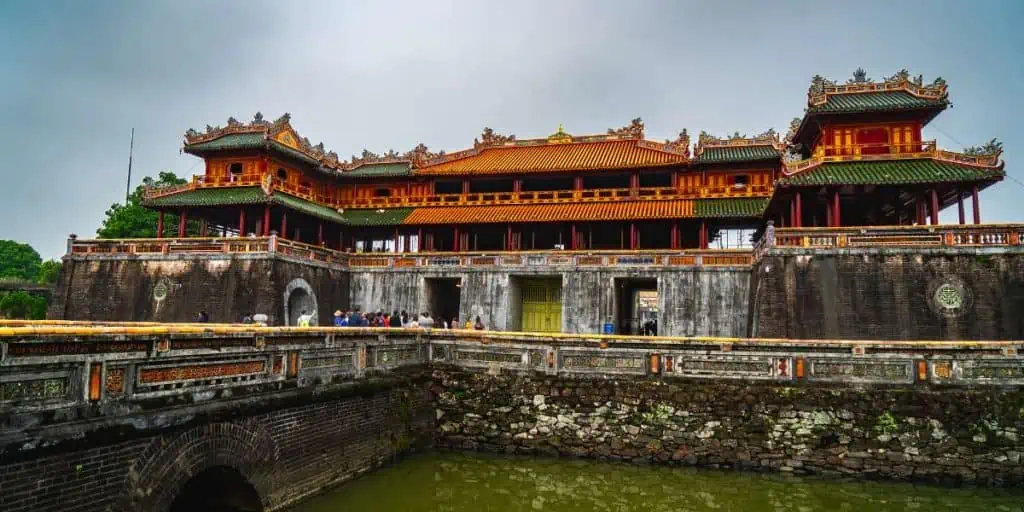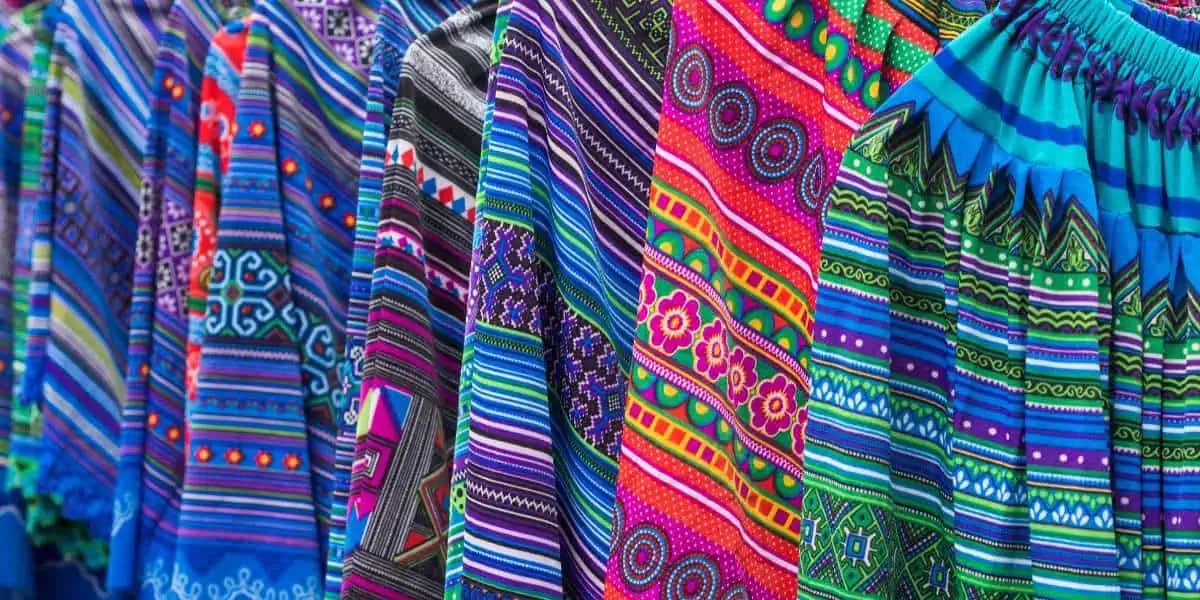Explore Vietnam’s captivating textile traditions – where lustrous silk and intricate embroidery interweave with heritage, craftsmanship, and exquisite beauty.
Vietnam’s textile scene forms a rich tapestry of vibrant colors, textures, and time-honored techniques that capture the imagination. Renowned particularly for the fine quality of its silk and the intricate art of its embroidery, Vietnamese textiles reflect remarkable artistry and cultural depth.
As the threads of various influences – from ancient dynasties to French colonial rule – have been woven into its fabric over centuries, Vietnam has nurtured uniquely diverse textile traditions. From the bustling silk and embroidery galleries of Hội An, to the hilltribe handicrafts of Sapa, the country is a paradise for artisanal creations.
A Tapestry of Silk
Silk is the opulent opus of Vietnamese textiles – the fabric that has been most exalted and coveted across the centuries. From quaint cottage enterprises to global high fashion houses, the allure of Vietnamese silk continues to capture attentions worldwide.
The Making of an Extraordinary Fabric
The road to producing the finest silk begins with the Bombyx mori – the domesticated silkworm that spins the valued filaments. These are harvested through an intensive process of cultivating mulberry leaves, facilitating cocoon formation, extracting fibers by hand, dyeing materials, and finally intensive weaving techniques.
Silkworm cultivation requires abundant yields of mulberry leaves – the silkworm’s exclusive food source. So the production process focuses heavily on mulberry propagation. The major silk producing areas like Van Phuc village have dedicated mulberry farms and vegetation integrated into cottage enterprises.
Once the mulberry-munching silkworms have constructed their cocoons, groups of artisans harvest the fine filaments. Using gentle techniques to extract long strands without breaking them, the silken threads are then naturally dyed and left to dry before being spun, woven and transformed into captivating fabric at the deft hands of talented weavers.
Diverse Applications
The luxurious nature and elegant sheen of silk has made it Vietnam’s premium textile for special attire and decor. From quintessential dresses to accessories and upholstery, silk elevates everything it touches.
The Áo dài – Vietnam’s iconic slim fitting tunic worn over trousers – is silk’s most famous ambassador. Regarded as the national dress, high quality embroidered silk Áo dài are treasured for special occasions like Tết (Lunar New Year Festivals). And contemporary designers use silk innovatively in modern fashion pieces too.
Beyond apparel, Vietnamese silk is also ubiquitous as a decorative fabric for embroidery, painting, and home furnishings. From opulent embroidered wall hangings to colorful silk lanterns, it lends its luxe appeal to any space.
Embroidery – A Tapestry of Threads
While silk forms the exquisite canvas, embroidery remains the metaphorical pen – bringing vibrant colors, lavish textures, and deep symbolism vividly to life. One cannot help but stand back in awe at the skill and intricacy of hand embroidery in Vietnamese textile arts.
Diverse Techniques
The tools may seem simple – fabric, hoop, needle, and thread. But in the hands of Vietnam’s master artisans, such basic ingredients yield extraordinary art.
Regional specialties have developed based on available materials and cultural influences. The Imperial City of Huế is renowned for its fine artwork using premium materials like gold threads, silk floss, and colorful lacquers on sheer fabrics.
Southern styles prefer cotton fabric with vibrant embroidery floss and close stitch counts to produce vivid imagery. Northern Vietnamese hill tribe groups use cross-stitch techniques with geometric patterns embellished with silver beads and buttons.
Regardless of regional variations, meticulous hand skills remain paramount. Young girls begin learning the techniques early – practising even basic stitches continuously till their tension and precision improves. Intricate designs require months or even years to complete a piece. But the end result reflects remarkable beauty and technical excellence.
Symbolic Significance
Beyond the visual beauty, Vietnamese embroidery also reveals meaningful messages encoded in cultural motifs. Since it historically adorned royal robes and national regalia, embroidery came to denote power and status. certain patterns were reserved for aristocracy’s exclusive use.
Depictions of natural elements and mythology also permeate the work. Birds and blossoms represent optimism. Fruits and seeds convey fertility and prosperity. Mythical creatures like dragons and phoenixes symbolize strength and eternal renewal. Abstract patterns also integrate cosmic elements and Yin-Yang iconography.
For the knowledgeable viewer, these symbolic accents enrich each piece’s beauty with deeper meaning. For they depict Vietnam’s unique visual language – one that has been spoken through colorful threads across centuries.
Cultural Landmarks of Textile Excellence
While silk and embroidery crafts exist nationwide, certain regions have risen to excellence as cultural textile landmarks for their historic legacies and modern vitality.
The Imperial City of Huế

The 19th century capital, Huế, retains immense cultural prestige despite its small size today. As the royal seat of power during the Nguyễn Dynasty, Huế became the nucleus of elite Vietnamese artistry, including opulent silk and embroidery initiatives that clothed the nobles in appropriate regalia splendor.
The iconic lotus flower’s meticulous depiction using rich floss silks and gold threads grew to be Huế’s artistic calling card. Even as the royal era faded into history, its cultural impact persevered. And Huế continues to produce exceptionally fine embroidery using premium materials upon sheer silk that is unmatched in quality elsewhere.
From quaint family-run silk shops in the city’s ancient citadel walls, to apprentice training initiatives reviving courtly styles – Huế remains devoted to upholding its imperial textile excellence.
The Merchant Hub of Hội An
While Huế’s silk glory lies in the past, the ancient port of Hội An presides firmly as contemporary Vietnam’s textile commerce hub. Its streets are filled with hundreds of tailor and fabric shops. And local artisans are renowned for their masterful craftsmanship of both silken apparel and embroidery art.
Established during the lucrative 16th-17th century spice trade era, the town’s merchant patronage fueled innovations in silk production and vibrant textile arts. Then as the port commerce declined, its people retained their artistry – particularly excelling at embroidery applied to both garments and artwork.
Today, Hội An’s bustling silk and lantern-lit streets are Vietnam’s shopping mecca. Tourists flock here to purchase custom tailored silk apparel or exquisite embroidery artworks bearing the town’s iconic symbol – the bright yellow Hoài River that flows through its heart.
The Hilltribes of Sapa Valley
Tucked within lush highland valleys near Vietnam’s northern borders, ethnic hilltribe villages have developed unique textile traditions that empower community culture. Groups like the Hmong and Dao craft vibrant attire and intricate handicrafts that economically sustain their self-sufficient lifestyles.
Using locally available fibers like hemp and embroidering geometric motifs in their own symbolic lexicon, each group’s textiles distinguish their identity. Skill mastery begins young with basic stitches, enabling even small children to contribute scraps that are ultimately integrated into larger pieces. Such collaborative efforts reinstate textile arts as fundamental to social bonds.
Many villages now welcome visitors to experience their cultural hospitality and artistry. Purchasing textiles directly from such communities aids their livelihoods during moderization pressures threatening their heritage. For when their handicraft prosperity and cultural heritage interweave, the fabrics of their communal identity remain resilient.
Embracing the Textile Experience
While photographs may showcase captivating glimpses, Vietnam’s textiles are best appreciated firsthand through tangible encounters across communities keeping these traditions alive.
Local Markets
Every town has its own bustling silk and textile marketplace – explosions of vibrant color from the seemingly endless variety available. Visitors can immerse themselves to explore diverse textiles at varied price points to understand quality benchmarks before purchasing at tailor shops or reputed galleries.
Haggle respectfully for the best deals and support elderly vendors struggling to uphold their artistry against mass-manufactured competition. For eventually one realizes handmade textiles reveal intricate efforts behind every stitch and woven thread – connecting us meaningfully to the artisan’s experience beyond the object’s utilitarian purpose.
Workshops
Alternatively, spending time at neighborhood embroidery workshops allows one to personally witness Vietnam’s knitting communities in action – where groups of artisans sit for long hours engrossed in their creative passion.
Patient masters may allow you participate by learning some starter stitches on practice cloth. Such firsthand experiences build deeper insight into the
intricacies of this delicate craft – transforming mere observers into active stakeholders celebrating the perseverance of Vietnam’s splendid textile heritage.
Galleries and Museums
Those keen on embroidery artworks besides apparel should visit reputed fine arts galleries to appreciate some true masterpieces. Top cities like Hanoi, Ho Chi Minh and Hoi An have specialized embroidery galleries within their bustling silk zones.
Exquisite designs use premium-grade vibrant silks or gauzy fine fabrics to create impressionistic scenes depicting Vietnam’s natural beauty and cultural narratives. Meticulous details reward closer inspection, yet retain an ethereal quality upon deeper appreciation.
Museums also showcase how silk cultivation and embroidery integrally relates to Vietnam’s dynastic history – ranging from imperial robes to folk attire permeating everyday aesthetics. The best galleries issue certificates of authenticity and assist with shipping logistics for overseas patrons.
Unique Souvenirs
Beyond mass-produced generic trinkets, many travelers desire meaningful mementos that personally connect them to the cultures encountered. Textiles remain globally cherished as cultural artifacts – everyday apparel in one region transformed into exotic décor overseas.
Instead of products churned out solely for tourist commerce, handmade silk or embroidered items purchased directly from village artisans better represent cultural exchange opportunities. Such collaborations support cottage industries upholding Vietnam’s splendid craftsmanship against globalization’s impersonal forces.
Whether a vibrant patterned silk scarf, the quintessential conical hat, or a delicate lotus-themed artwork – when thoughtfully procured, textiles make wonderful Vietnamese souvenirs. For their threads quite literally interweave your destinies.
Conclusion: A Fabric of Cultural Pride
Through the vibrant tapestry of Vietnamese textiles flows the creative spirit that has clothed, inspired and united its people across history’s fabric. Despite the inevitable fading of older courtly traditions, contemporary Vietnam retains immense cultural pride for the silk and embroidery excellence still flourishing nationwide through the passionate persistence of talented craftspeople.
As global exposure increasingly threatens localized art forms with extinction, patronizing Vietnamese textiles accelerates heritage preservation efforts while bringing delighted new life to home decors worldwide. By inspiring travelers to become silk and embroidery’s thoughtful ambassadors rather than mere commoditizing consumers, perhaps the threads of cultural appreciation may ultimately strengthen the weave of humanity.





